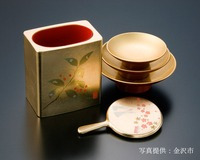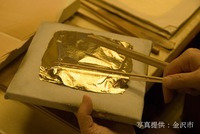

Total:131items
- Pottery & Porcelain (18)
- Lacquerware (4)
- Glasswork (2)
- Wood & Bamboo Work (19)
- Leather Work (1)
- Papermaking (13)
- Textile (20)
- Dyeing products (5)
- Masonry (1)
- Metal Work (11)
- Stationery (4)
- Livingware (3)
- Accessory (4)
- Toys & Entertainment (14)
- Interior (2)
- Other crafts (10)
- Osaka Shamisen (Japanese three-stringed guitar)
- Kyo-Hanga: Kyoto woodblock print
- Hyuga Kendo Armor
- Kanazawa-Haku: Kanazawa Gold Leaf
- Simotsuke-Suisha: Simotsuke Waterwheel
- Koshigaya-Katchu: Japanese traditional armor
- Ise netsuke : Ise miniature wooden sculpture
- Yuton: Lacquered Paper Mat
- Iwami Kagura Mask
- Oroku-gushi: Oroku-gushi Combs

 |
Main Production Site:Ishikawa |
 《Characteristics》
《Characteristics》Kanazawa Gold Leaf creates a brilliant and radiant beauty in various kinds of arts and architectures: from temples such as Kinkakuji-temple and Nikko Toshogu-temple to handicrafts such as lacquer wares, Buddhist alters, Buddhist instruments and fabrics. The gold leaf produced in Kanazawa accounts for more than 98 percent of the total amount of gold leaf production in Japan. The graceful Kanazawa Gold Leaf which glows beautifully has been used for art crafts and has supported the traditional culture of wealthy Kaga domain, current Ishikawa Prefecture, Central Japan.
Even a gold leaf is beaten to a thickness of 1/10,000 mm and almost transparent, it never lose its glow and even thickness. Manufacturing gold leaf is not as simple as merely beating and stretching out gold thus it requires skilled techniques in each process.
In 1977, Kanazawa Gold Leaf became first to be designated as Traditional Craft Products in the material and equipment category by the Minister of Economy, Trade and Industry of Japan.
Kanazawa Gold Leaf is now used more widely, such as for interior in addition to Buddhist instruments and art crafts.
[National Designated Traditional Craft (designated by Economy, Trade and Industry Minister)]
Information provided by Cooperative Association for the Leaf Trade Industry of Ishikawa Prefecture
Translation by Naoko Yamashita, reviewed by Marie Mine

| Materials | Pure gold, pure silver, pure copper |
|---|---|
| Crafting Processes | [1]Gold Alloying
Pure gold, pure silver and pure copper are melted in a melting furnace and poured into a mold, making molded gold alloy. [2]Stretching Gold The molded alloy is rolled into strips of approximately 5-6/100 mm thick in a rolling mill. [3]Small Sheet Wrapping The gold sheet cut into 6cmpieces are placed between "Zumi-uchi Gami", foil-beating paper one by one, then wrapped in leather bag and stretched out in a beating machine. [4]Stretching Sheets to Foil The stretched gold is gradually moved into larger paper five times, forming an approximately 21cm square and 1 or 2/1000mm thick foil. [5]Foil Cutting and Wrapping The foil is cut into approximately 11 to 12 equal portions. The items are placed in between prepped "Haku-uchi Gami" , leaf-beating paper, and wrapped in leather bag with approximately 1,800 sheets making up one pack. [6]Pre-Beating (Leaf Beating) The packs wrapped in leather bag are beat for roughly three minutes in a leaf beating machine, cooled off for 15 minutes, and the process is repeated dozens of times until the pack is beat and stretched out to a thickness of roughly 1/10,000mm. [7]Leaf Transfer The gold leaf is placed on top of a leather board, cut one by one into the standard size squares with a bamboo frame, placed between handmade interleaf paper, and finished. [8]Gilding The foil is elaborately placed on an object one by one with an adhesive such as lacquer, making the object into a gorgeous gold leaf product. |
| History | It is obvious that the production of gold leaf in Kanazawa had already started as early as the late 16th century. In 1593, Maeda Toshiie, a founder of Kaga (current Ishikawa Prefecture, Central Japan) domain, ordered the production of gold leaf in Nanao, and silver leaf in Kanazawa (both in current Ishikawa Prefecture) when he was in camp of Hizen Nagoya (current Saga Prefecture, Southern Japan) for then chief adviser of the Emperor, Toyotomi Hideyoshi's first campaign against Korea.
Since then, the production of gold leaf has been promoted in accordance with the arts and crafts promotion policy as a part of industrial promotion policy of the Kaga domain. Also, the flourishing of Jodo Shinshu Buddhism (True Pure Land sect) brought by Rennyo (the 8th Monshu, or head-priest, of the Honganji Temple) boosted a demand for gold leaf to build new temples and to make Buddhist alters and Buddhist instruments. In addition, Kanazawa's climatic factors; climate, temperature and good water quality appropriate for gold leaf manufacturing, made Kanazawa the main production site of gold leaf. |
◆Exhibition / Showcase
Cooperative Association for the Leaf Trade Industry of Ishikawa Prefecture Hall
Address: Fukuhisamachi Ro-172, Kanazawa-city,
920-3122 Ishikawa Prefecture
TEL: +81-(0)76‐257-5572 / FAX: +81-(0)76‐257-5583 (Japanese only)
Open hours: 9:00 a.m. to 4:30 p.m.
Closed on Saturdays, Sundays, Japanese National holidays, during Bon holiday period in mid August, and Year-end and New Year holidays (12/28-1/4)
Assistance needed? For inquiries in English:
JTCO Contact Form
Your inquiries will be forwarded by JTCO in Japanese to the organization you wish to contact.
Please specify the name of the craft/art you wish to inquire about.



